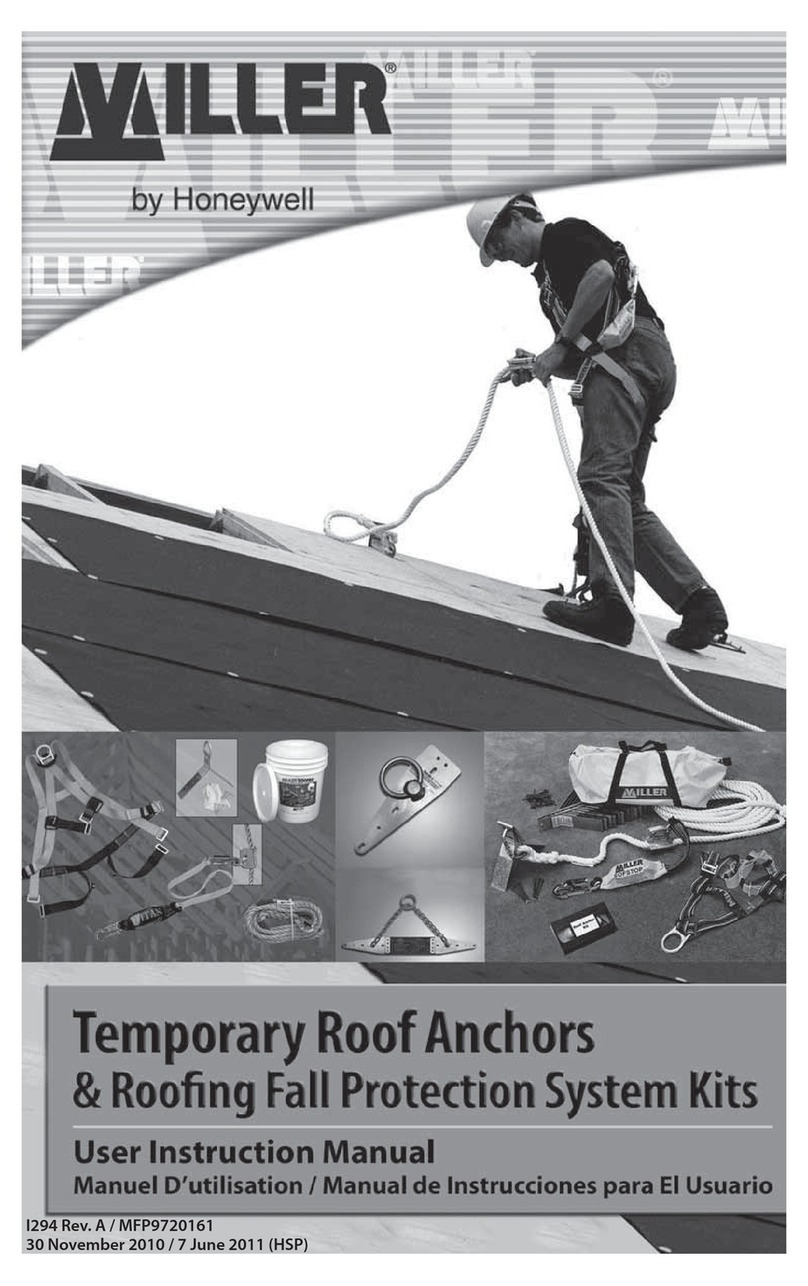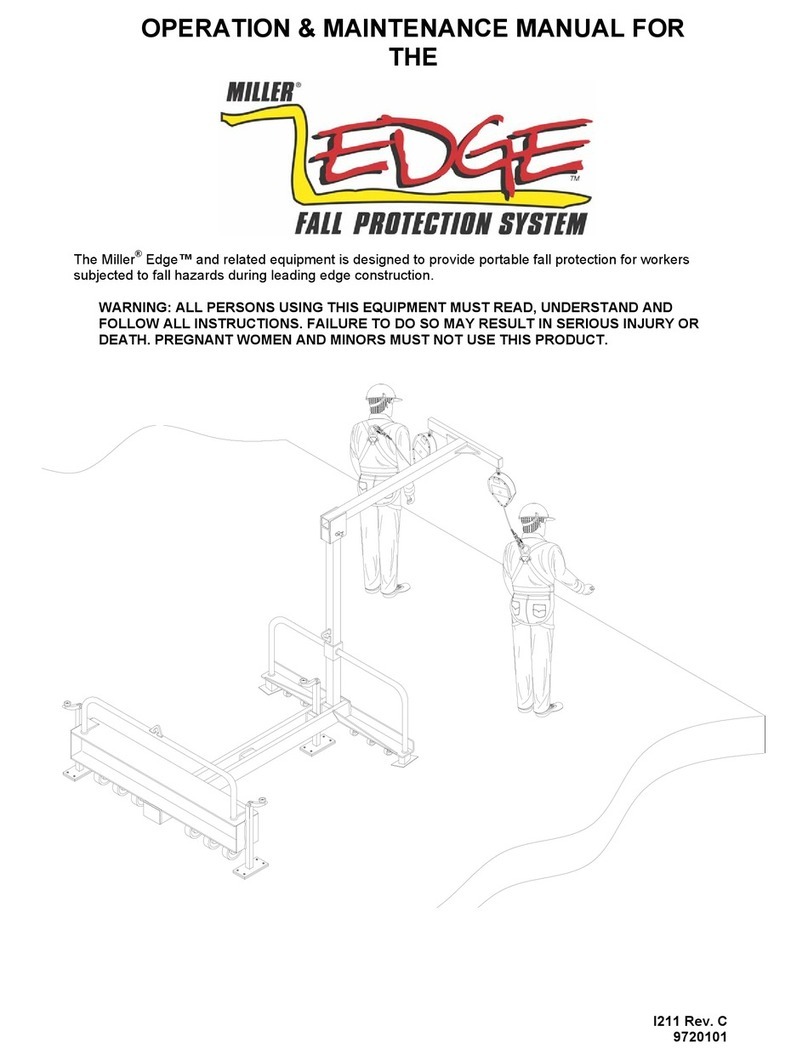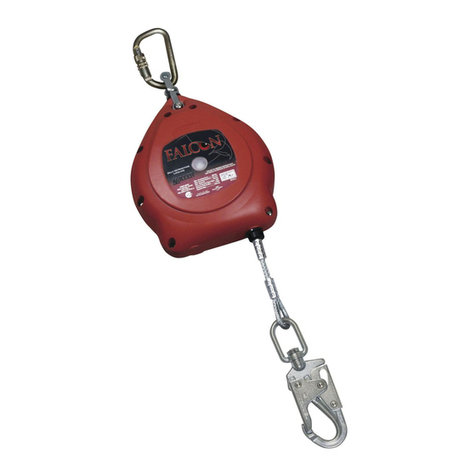
User Instructions - English
4
System Compatibility
Xenon Kits are designed for use with Miller approved com-
ponents. Substitution or replacement with non-approved
component combinations, sub-systems, or both, may affect
or interfere with the safe function of each other and endan-
ger the compatibility within the system. This incompatibility
may affect the reliability and safety of the total system.
Miller Fall Protection requires the use of a Miller full-body
harness and shock-absorbing lanyard or self-retracting life-
line/fall limiter with this system. All instructions and warnings
provided with the body wear and connecting device must be
read and understood before using the equipment.
Maximum Lifeline Span
The maximum lifeline span (from anchor to anchor, from
anchor to intermediate bracket, or from intermediate bracket
to intermediate bracket) is 30 ft. (9.1m). System kits are
available in lengths from 30 ft. (9.1m) to 510 ft. (155.5m).
Any lifeline system extending beyond 30ft. (9.1m), known as
a multiple-span system, requires intermediate brackets at a
maximum of 30 ft. (9.1m) intervals.
Capacity
Maximum capacity is two (2) workers [310lbs (140.6kg)
each] for a single shock absorber system and four (4)
workers [310lbs (140.6kg) each] for a double shock absorber
system. Capacity ratings assume the anchorage or structure
to which the horizontal lifeline kit is installed meets the load
requirements.
System Forces
The Xenon Kit is equipped with an inline shock absorber. In
the event of a fall, the shock absorber limits system forces.
Fall Arrest Forces
In conjunction with the Xenon Horizontal Lifeline System,
workers must use a Miller self-retracting lifeline/fall limiter or
a shock-absorbing lanyard, which limits maximum fall arrest
force imposed by the worker to 900lbf (4kN).
Free Fall
Personal fall arrest systems must be rigged to limit a free fall
to the shortest possible distance [6ft (1.8m) maximum].
Fall Clearance
Ensure that adequate clearance exists in your fall path to
avoid striking a lower level or other object (see 6.0 Fall
Clearance).
Environmental Hazards
Use of this equipment in areas where environmental
hazards exist may require additional precautions to limit the
possibility of injury to the user or damage to the equipment.
Hazards may include, but are not limited to, extreme
temperatures, caustic chemicals, corrosive environments,
high voltage power lines, explosive or toxic gases, moving
machinery, and sharp edges. Do not expose the equipment
to any hazard which it is not designed to withstand. Consult
the manufacturer in cases of doubt.
2.2 System Warnings and Limitations
End and Intermediate System Load Requirements*
[lbf. (kN)] for Xenon HLL Systems
Single-Span Systems
System/
Span
Length
[ft. (m)]
Single Shock Absorber
System for 1-2 Workers Double Shock Absorber
System for 3-4 Workers
End
Load Intermediate
Load End
Load Intermediate
Load
10
(3m) 3294 lbf.
(14.7kN) 2420 lbf.
(10.8kN) 3790 lbf.
(16.9kN) 3660 lbf.
(16.3kN)
15
(4.5m) 3786 lbf.
(16.8kN) 2420 lbf.
(10.8kN) 4374 lbf.
(19.5kN) 3660 lbf.
(16.3kN)
20
(6.1m) 4330 lbf.
(19.3kN) 2420 lbf.
(10.8kN) 4910 lbf.
(21.8kN) 3660 lbf.
(16.3kN)
25
(7.6m) 4686 lbf.
(20.8kN) 2420 lbf.
(10.8kN) 5342 lbf.
(23.8kN) 3660 lbf.
(16.3kN)
30
(9.1m) 4968 lbf.
(22.1kN) 2420 lbf.
(10.8kN) 5812 lbf.
(25.9kN) 3660 lbf.
(16.3kN)
Multiple-Span Systems (with 30 ft. spans)
System
Length
[ft (m)]
Single Shock Absorber
System for 1-2 Workers Double Shock Absorber
System for 3-4 Workers
End
Load Intermediate
Load End
Load Intermediate
Load
30
(9.1m) 4968 lbf.
(22.1kN) 2420 lbf.
(10.8kN) 5812 lbf.
(25.9kN) 3660 lbf.
(16.3kN)
60
(18.2m) 4692 lbf.
(20.9kN) 2420 lbf.
(10.8kN) 5556 lbf.
(24.7kN) 3660 lbf.
(16.3kN)
90
(27.4m) 4458 lbf.
(19.8kN) 2420 lbf.
(10.8kN) 5344 lbf.
(23.8kN) 3660 lbf.
(16.3kN)
120
(36.5m) 4302 lbf.
(19.1kN) 2420 lbf.
(10.8kN) 5192 lbf.
(23.1kN) 3660 lbf.
(16.3kN)
150
(45.7m) 4132 lbf.
(18.4kN) 2420 lbf.
(10.8kN) 5034 lbf.
(22.4kN) 3660 lbf.
(16.3kN)
180
(54.8m) 4006 lbf.
(17.8kN) 2420 lbf.
(10.8kN) 4910 lbf.
(21.8kN) 3660 lbf.
(16.3kN)
210
(64m) 3906 lbf.
(17.4kN) 2420 lbf.
(10.8kN) 4840 lbf.
(21.5kN) 3660 lbf.
(16.3kN)
240
(73.1m) 3794 lbf.
(16.9kN) 2420 lbf.
(10.8kN) 4716 lbf.
(21kN) 3660 lbf.
(16.3kN)
270
(82.2m) 3718 lbf.
(16.5kN) 2420 lbf.
(10.8kN) 4638 lbf.
(20.6kN) 3660 lbf.
(16.3kN)
300
(91.4m) 3640 lbf.
(16.2kN) 2420 lbf.
(10.8kN) 4550 lbf.
(20.2kN) 3660 lbf.
(16.3kN)
330
(100.5m) 3574 lbf.
(15.9kN) 2420 lbf.
(10.8kN) 4490 lbf.
(20kN) 3660 lbf.
(16.3kN)
360
(109.7m) 3504 lbf.
(15.6kN) 2420 lbf.
(10.8kN) 4414 lbf.
(19.6kN) 3660 lbf.
(16.3kN)
390
(118.8m) 3442 lbf.
(15.3kN) 2420 lbf.
(10.8kN) 4364 lbf.
(19.4kN) 3660 lbf.
(16.3kN)
420
(128m) 3388 lbf.
(15.1kN) 2420 lbf.
(10.8kN) 4304 lbf.
(19.2kN) 3660 lbf.
(16.3kN)
450
(137.1m) 3342 lbf.
(14.9kN) 2420 lbf.
(10.8kN) 4248 lbf.
(18.9kN) 3660 lbf.
(16.3kN)
480
(146.3m) 3290 lbf.
(14.6kN) 2420 lbf.
(10.8kN) 4196 lbf.
(18.7kN) 3660 lbf.
(16.3kN)
510
(155.4m) 3242 lbf.
(14.4kN) 2420 lbf.
(10.8kN) 4148 lbf.
(18.5kN) 3660 lbf.
(16.3kN)
System Requirements
The Horizontal Lifeline System shall be designed, installed
and used, under the supervision of a qualied person,
as part of a complete personal fall arrest system, which
maintains a safety factor of at least two.
Ensure that there is adequate end and intermediate anchorage
strength for the Xenon HLL System per the chart below. *Load
requirements reect a 2:1 safety factor.































